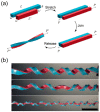Helical Structures Mimicking Chiral Seedpod Opening and Tendril Coiling
- PMID: 30200611
- PMCID: PMC6164363
- DOI: 10.3390/s18092973
Helical Structures Mimicking Chiral Seedpod Opening and Tendril Coiling
Abstract
Helical structures are ubiquitous in natural and engineered systems across multiple length scales. Examples include DNA molecules, plants' tendrils, sea snails' shells, and spiral nanoribbons. Although this symmetry-breaking shape has shown excellent performance in elastic springs or propulsion generation in a low-Reynolds-number environment, a general principle to produce a helical structure with programmable geometry regardless of length scales is still in demand. In recent years, inspired by the chiral opening of Bauhinia variegata's seedpod and the coiling of plant's tendril, researchers have made significant breakthroughs in synthesizing state-of-the-art 3D helical structures through creating intrinsic curvatures in 2D rod-like or ribbon-like precursors. The intrinsic curvature results from the differential response to a variety of external stimuli of functional materials, such as hydrogels, liquid crystal elastomers, and shape memory polymers. In this review, we give a brief overview of the shape transformation mechanisms of these two plant's structures and then review recent progress in the fabrication of biomimetic helical structures that are categorized by the stimuli-responsive materials involved. By providing this survey on important recent advances along with our perspectives, we hope to solicit new inspirations and insights on the development and fabrication of helical structures, as well as the future development of interdisciplinary research at the interface of physics, engineering, and biology.
Keywords: biomimetic; helical structures; perversion; seedpod opening; stimuli-responsive materials; tendril coiling.
Conflict of interest statement
The authors declare no conflict of interest.
Figures



















Similar articles
-
Liquid Crystal Elastomer Artificial Tendrils with Asymmetric Core-Sheath Structure Showing Evolutionary Biomimetic Locomotion.Adv Mater. 2024 Feb;36(7):e2307210. doi: 10.1002/adma.202307210. Epub 2023 Dec 7. Adv Mater. 2024. PMID: 37805917
-
Preparation of biomimetic photoresponsive polymer springs.Nat Protoc. 2016 Oct;11(10):1788-97. doi: 10.1038/nprot.2016.087. Epub 2016 Sep 1. Nat Protoc. 2016. PMID: 27583641
-
Facile Integration of Bacterial Cellulose with Liquid Crystal Elastomers Enables Robust Biomimetic Helical Yarn Actuators.Small. 2025 Mar;21(11):e2411178. doi: 10.1002/smll.202411178. Epub 2025 Feb 10. Small. 2025. PMID: 39930741
-
Shape-Memory Polymeric Artificial Muscles: Mechanisms, Applications and Challenges.Molecules. 2020 Sep 16;25(18):4246. doi: 10.3390/molecules25184246. Molecules. 2020. PMID: 32947872 Free PMC article. Review.
-
Materials for Smart Soft Actuator Systems.Chem Rev. 2022 Jan 12;122(1):1349-1415. doi: 10.1021/acs.chemrev.1c00453. Epub 2021 Dec 27. Chem Rev. 2022. PMID: 34958196 Review.
Cited by
-
Performance of molecular crystals in conversion of light to mechanical work.Proc Natl Acad Sci U S A. 2021 Feb 2;118(5):e2020604118. doi: 10.1073/pnas.2020604118. Proc Natl Acad Sci U S A. 2021. PMID: 33495317 Free PMC article.
-
Intelligent Shape-Morphing Micromachines.Research (Wash D C). 2021 May 12;2021:9806463. doi: 10.34133/2021/9806463. eCollection 2021. Research (Wash D C). 2021. PMID: 34056618 Free PMC article. Review.
-
A mathematical model for the auxetic response of liquid crystal elastomers.Philos Trans A Math Phys Eng Sci. 2022 Oct 17;380(2234):20210326. doi: 10.1098/rsta.2021.0326. Epub 2022 Aug 29. Philos Trans A Math Phys Eng Sci. 2022. PMID: 36031830 Free PMC article.
-
Nematic liquid crystalline elastomers are aeolotropic materials.Proc Math Phys Eng Sci. 2021 Sep;477(2253):20210259. doi: 10.1098/rspa.2021.0259. Epub 2021 Sep 8. Proc Math Phys Eng Sci. 2021. PMID: 35153581 Free PMC article.
-
Bioinspired Self-Shaping Clay Composites for Sustainable Development.Biomimetics (Basel). 2022 Jan 10;7(1):13. doi: 10.3390/biomimetics7010013. Biomimetics (Basel). 2022. PMID: 35076468 Free PMC article.
References
-
- Goriely A., Tabor M. Spontaneous Helix Hand Reversal and Tendril Perversion in Climbing Plants. Phys. Rev. Lett. 1998;80:1564–1567. doi: 10.1103/PhysRevLett.80.1564. - DOI
-
- Guo Q., Chen Z., Li W., Dai P., Ren K., Lin J., Taber L.A., Chen W. Mechanics of tunable helices and geometric frustration in biomimetic seashells. EPL (Europhys. Lett.) 2014;105:64005. doi: 10.1209/0295-5075/105/64005. - DOI
-
- Jung W., Choi S.M., Kim W., Kim H.Y. Reduction of granular drag inspired by self-burrowing rotary seeds. Phys. Fluids. 2017;29:041702. doi: 10.1063/1.4979998. - DOI
Publication types
MeSH terms
Substances
Grants and funding
LinkOut - more resources
Full Text Sources
Other Literature Sources
Molecular Biology Databases

